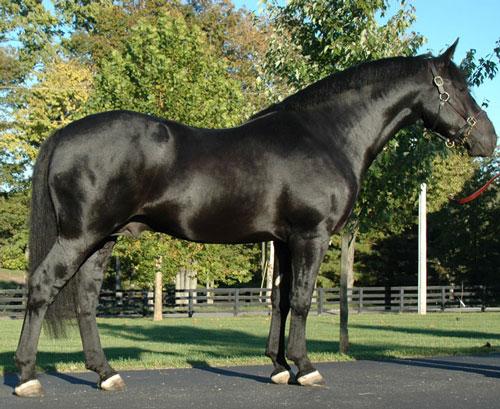
Continent: Europe
Country: Ireland
Weight: 550 – 700 kg
Height: 155 – 173 cm
The Irish Draught Horse is a horse breed originating from Ireland, developed as early as the 17th century. It was created to meet the need for a versatile horse, capable of working in the fields, pulling heavy loads, but also suitable for riding and military purposes.
It results from crosses between local Irish horses (often of Iberian type dating back to the medieval period) and contributions from the Thoroughbred, Clydesdale, and Shire, which gave it a more powerful stature while preserving the agility required for the hilly and sometimes difficult terrain of Ireland.
The Irish Draught is primarily bred in Ireland, where it is an important part of rural heritage. Its numbers are concentrated in:
From the 19th century, the breed was exported to England and Scotland, where it was integrated into certain draught and sport horse breeds. Today, it remains present in several British studbooks.
The Irish Draught has also spread to:
The Irish Draught forms the foundation of the Irish Sport Horse, famous worldwide for its performance in show jumping, eventing, and fox hunting. Its genetic contribution ensures a strong bone structure, great stamina, and a reliable temperament.
Thanks to its powerful frame, sound limbs, and hardiness, it adds durability and natural resistance to crossbreeding, compensating for the weaknesses of some Thoroughbred-derived lines.
Threatened by agricultural mechanization, the Irish Draught remains today a valuable genetic reservoir, preserved through the Irish Draught Horse Society. Its conservation is essential to maintain a balance between strength, docility, and sporting aptitude in European breeding.
The Irish Draught descends from local horses, already influenced by Iberian breeds introduced to Ireland during the Middle Ages. By the 17th century, Irish farmers sought a versatile horse capable of working fields, pulling carts, but also being ridden for hunting and daily travel.
Over time, breeders introduced the Thoroughbred (to refine and add speed), as well as the Clydesdale and Shire (to increase strength and size). This combination produced a unique horse: both strong and enduring, yet more agile and manageable than other European draught breeds.
From the 18th to the 19th century, the Irish Draught was used both as a war horse and as an agricultural helper. Versatile, it could pull wagons, carry a rider, or work the land. Its reputation as a trustworthy and courageous animal spread throughout Ireland.
To prevent the breed from being diluted through excessive crossbreeding, the first official Irish Draught studbook was created in 1907. This milestone helped preserve its identity and define a morphological standard.
With 20th-century mechanization, numbers fell sharply and the breed nearly disappeared. A conservation movement began in the 1970s, leading to the creation of the Irish Draught Horse Society. Since then, populations have stabilized, and the breed has regained international recognition, particularly through its role in developing the Irish Sport Horse.
The Irish Draught is renowned for its calmness and emotional stability. It shows patience, steadiness, and adapts well to various environments, making it an excellent partner for farming, trekking, or sport when crossed.
Unlike heavier draught horses, it retains natural vigor and good stamina without excessive energy. This makes it both powerful and manageable, able to work for long periods without tiring quickly.
The Irish Draught enjoys human contact and is generally docile and cooperative. In herds, it displays a peaceful temperament, integrating well into social hierarchies, which eases its management both in breeding and in leisure contexts.
Hardy and strong, it enjoys better longevity compared to many other draught breeds. Its relatively simple upkeep and natural resistance allow it to remain active for a long time, whether in professional use or leisure riding.
“The Irish Draught embodies quiet strength: a reliable, docile, and enduring horse, valued as much for its robustness as for its endearing character.”
The future of the Irish Draught is closely tied to the Irish Sport Horse, for which it remains the essential genetic foundation. Its ability to pass on soundness, resistance, and a balanced mind makes it indispensable for producing competitive and durable sport horses.
Although long used almost exclusively in crossbreeding, there is now a renewed interest in purebred Irish Draughts. Conservation programs encourage selective breeding to avoid the loss of genetic diversity.
With its docile temperament and controlled strength, the Irish Draught is attracting more amateur riders seeking a safe leisure horse and a reliable partner for trekking. This trend opens new perspectives beyond elite sport.
In Ireland, the Irish Draught is recognized as a national symbol. Its preservation is part of a broader cultural heritage initiative, supported by the Irish Draught Horse Society and by breeder subsidies. The breed’s future relies on balancing sporting use, cultural value, and conservation programs.
The Irish Draught is recognized for its hardiness and solid constitution. Traditional selection aimed at producing a resistant horse capable of working in challenging conditions, which has given it a strong health and superior longevity compared to many other draught breeds.
Like all traditional breeds, some issues exist:
To safeguard the breed, the Irish Draught Horse Society imposes strict veterinary checks for breeding horses (fertility, X-rays, limb evaluation). This limits the spread of hereditary flaws and ensures a healthy stock.